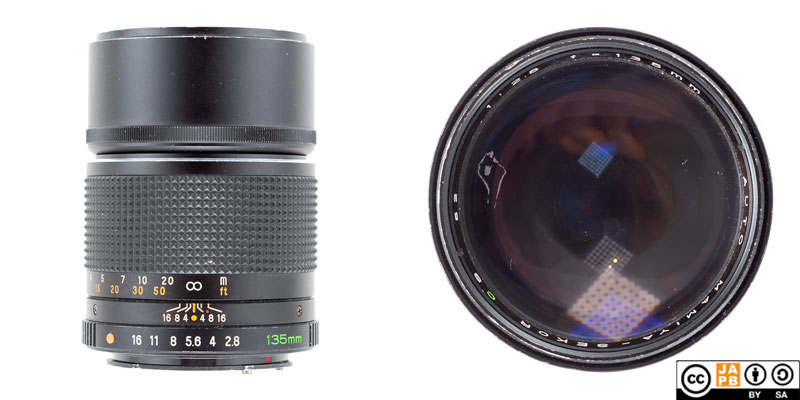Pekka Buttler, 10/2024

Specifications
The table below summarizes the lens’ key specifications (measurements based on pictured sample):
| Brand: | Mamiya-Sekor | Lens name | CS 1:2.8 f=135mm |
| Focal length(s)1 | 135 mm | Angle-of-view2 | 18° |
| Maximum Aperture | f/2.8 | In Production | 1977-1980 |
| Lens mount | Mamiya NC/CS | Subfamily (if applicable) | –– |
| Length3 | 79,7 mm | Diameter4 | 61,1 mm |
| Filter ring diameter | 52 mm | Weight | 314 grams |
| Lens element count | 5 | Lens group count | 4 |
| Aperture blades (S/R/C)5 | 5 S | Focus throw | 210 ° |
| Minimum focusing distance | 1,5 m | Maximum magnification | 1:6,9 |
| Has manual aperture ring | YES | Has Manual focus ring | YES |
| Aperture mechanism type | Auto | Aperture click stops 6 | 2.8-4-5.6-8-11-16 |
Further notes:
• In 1977 Mamiya introduced the NC1000 line of cameras and lenses.
• For the NC1000 camera, Mamiya introduced 14 lenses, including this 135 mm f/2.8 medium tele lens.
• This lens is a relatively radical redesign compared with Mamiya’s previous 135/2.8 lens (the Mamiya/Sekor SX Auto 135mm F/2.8). With one more lens element, this lens is significantly more compact and lighter than its predecessor. This optical design was retained as Mamiya moved onward to its Z/E mount in 1980.
• At only 314 grams and only 79,7 mm in length, this is a very compact 135 mm f/2.8 design. Even so, in this package comes a built-in extendable lens hood.
• The aperture mechanism of Mamiya NC/CS lenses is auto-only, meaning that the aperture ring never directly controls the aperture diaphragm. Instead, the aperture ring sets the value to which the aperture will be closed down when the camera actuates the lens’ aperture stop-down pin.
Versions
This lens was in production for only ≈4 years, and it has no direct predecessor, as this was Mamiya’s first 135 m f72.8 lens with a 5 elements in 4 groups design. However, it is closely related to its successor, the Mamiya-Sekor E 135 mm f/2.8 (Z/E mount)
History of Mamiya NC/CS lenses
Please see the JAPB article on all (7) Mamiya SLR lens mounts to understand the role of the Mamiya NC/CS mount .
Adapting
n.B! The following applies to all Mamiya NC/CS mount lenses.
This lens cannot be used natively on any current SLR or dSLRs. To use it in its native environment, you will need a Mamiya NC1000 or NC1000s film body.
While the Mamiya NC/CS system was quickly overtaken by events, the cameras themselves were thoughtfully designed and well-made and many remain perfectly serviceable today. Alternatively, you can use most of the features of the lens on a Mamiya ZE or ZE-2 body (these early Mamiya Z/E system bodies have the ability to both mount Mamiya NC/CS lenses and activate their aperture mechanism. See more, in the JAPB article on all (7) Mamiya SLR lens mounts).
While Mamiya NC/CS lenses are otherwise straightforward and purely mechanical, they need the camera body (or adapter) to depress the aperture stop-down pin for the aperture ring to have any significance.
Therefore, should you aim to adapt this lens to a mirrorless camera you will need an adapter that facilitates adjusting the lens’ aperture. Luckily, every Mamiya NC/CS adapter I’ve seen does offer such a functionality. However, due to Mamiya NC/CS lenses not being among the most numerously manufactured, none of the major adapter manufacturers have Ma
special adapters (helicoid adapters, tilt/shift adapter and speed boosters) are currently unavailable and adapter availability can generally not be taken for granted.
Using Mamiya NC/CS lenses on dSLRs is also theoretically possible. However, due to that the, difference in flange focal distances between the Mamiya NC/CS lens and the dSLR mount (between +1,5 mm and negative 1 mm) invariably does not allow sufficient space for an adapter that allows aperture modification, these adapters are always adapters with added optics to achieve infinity focus.
Importantly, while you can mount Mamiya NC/CS lenses on Mamiya Z/E system adapters, these adapters will not allow you to change the lens’ aperture.
Footnotes
- Focal length is (unless stated otherwise) given in absolute terms, and not in Full-frame equivalent. For an understanding of whether the lens is wide/tele, see ‘Angle-of-view’. ↩︎
- Picture angle is given in degrees (based on manufacturers’ specs) and concerns the diagonal picture angle. Rule of thumb:
> 90 ° ==> Ultra-wide-angle
70–90 ° ==> Wide-angle
50–70 ° ==> Moderate wide-angle
40–50 ° ==> ‘Standard’ or ‘normal’ lens
20–40 ° ==> Short tele lens
10-20 ° ==> Tele lens
5-10 ° ==> Long tele lens
< 5 ° ==> Ultra-tele lens ↩︎ - Length is given from the mount flange to the front of lens at infinity. ↩︎
- Diameter excludes protrusions such as rabbit ears or stop-down levers. ↩︎
- S=straight; R=rounded; C=(almost)circular at all apertures. ↩︎
- Numbers equal aperture values on aperture ring; • intermediate click; – no intermediate click. ↩︎